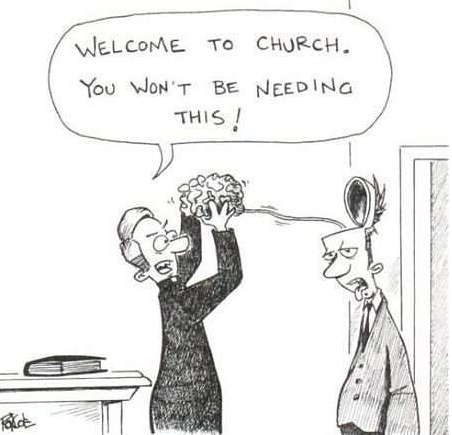In at least one instance, Paul preached so long, someone went to sleep, fell out of a window, and died (Acts 20:9). I don’t think I’d recommend that as a sermon strategy.

Context, and the text itself, are likely the most important parameters to shape sermons, but the evidence is piling up that long sermons work against retention and recall of information, and speaking below the audience’s intellect and interest is another sure way to fail.

It has been said that “the best preachers develop audience awareness, always discerning how well folks are listening. Respond to their restlessness with energy, focus and excitement about the text. Is your voice lulling them to sleep? Change your pitch, pace and volume. Let the Word that has saturated you in your study overflow in your pulpit to them in the pew. You may preach as one who knows the Word, but do you preach as one who loves the Word? They’ll listen better—and sit longer.” (The long and short of sermons)
Reasonably short sermons acknowledge that our attention span is limited. As a former QUT lecturer in the Education Faculty I soon learnt about attention span. Despite continued practice of 50-minute lecture, the academic literature is full of articles and books supporting and propagating the conclusion that lectures should adhere to the 10- to 15-min attention span that is characteristic of modern students. In the book Tools for Teaching, Davis (link) states that “…student attention during lectures tends to wane after approximately 10–15 minutes.” Similarly, Wankat (link) argues that “Although student attention is high at the start of a lecture, it has reached a low point after 10–15 minutes.” When the lecture begins, most students are paying attention, and for most students that attention lasts for about 10 minutes. Indeed, McKeachie (link), in Teaching Tips (8th Ed.), has maintained that “Attention typically increases from the beginning of the lecture to 10 minutes into the lecture and decreases after that point.” But do we need the research evidence. Isn’t it obvious? Just look at the audience after 15 minutes, or better still, stop and ask them a question about what you have said so far!
Teachers who move into conversation with their audience gain better attention also. The audience likes to feel their opinions are valued and that they are not empty vessels there to be filled.
But the difference between teaching and preaching is important. Jesus used both. They complement each other when it comes to getting a message across.
Matthew 11:1 says, “When Jesus had finished instructing his twelve disciples, he went on from there to teach and preach in their cities”.
This is the difference between preaching and teaching in the Bible:
Preaching is proclamation. Teaching is education.
Preaching is announcing. Teaching is instructing.
Preaching is making a declaration. Teaching is making a disciple (Matthew 28:19-20).
In the original Greek that the New Testament was written in, the Bible uses one root word that we translate to the English word teach (didasko), but there are two root words that we often translate as preach (kerysso and euangelizo). Preaching should use all three. The first word, kerysso, means to announce; proclaim; make known. The second word, euangelizo, which has a similar construction as the Greek word for evangelism (euangelion), means to proclaim good news, announce good news, or proclaim the gospel.
Jesus didn’t just teach; he announced good news. In good preaching we announce and educate, a combination of proclamation and practical advice. doing one without the other is not serving the audience well. (Brandon Hilgemann)
In summary keep it down to 15 minutes maximum and experiment with mutimedia, varied voice, interaction with the audience, and combine proclamation with teaching.
Your thoughts?
Paul Inglis, March 2024
oOo

Nice piece! Thank-you. I’m a teacher from another century, and am going to send this attachment on to one of my much-loved grandsons, a very sceptical young man who doesn’t go to Church (with all that implies) and at 30, after a distinguished but not world- class career in music performance, has enrolled in teacher education, specializing in secondary school music teaching. I tell him teaching is the noblest profession – and I’m hoping he turns into a good teacher, not a boring preacher. Best wishes Lesley Shaw
He has a promising future with your encouragement.
Yes, wise advice—thanks, Paul.
Be blessed, all you lovely UCA members, that your relatively minor problems are merely stylistic ones! In the Royal Commission Report (on the non-reporting of Child Abuse) the Commissioners recommended that, as in all public institutions in the democratic world, Church organisations attend to three factors deemed in the repot to be manifestly missing in Catholic institutions: viz. participative decision-making, accountability & transparency. Our Pope, Francis, is still struggling to sell the first aspect of this advice to a largely sceptical & unresponsive Church hierarchy. Not for nothing in my deeply Catholic but envious view, did the Reformation sweep through North-Western Europe, where these practices are enshrined!
Among the Eastern Fathers, there is this piece of good advice: Keep your sermons short, and to the point (unless of course, you are addressing a Conclave of bishops, or a Council of Emperors)…. 🙂 So here is a that advice: (attributed to Chrysostom no less…)
“Hearken, O brethren, to the wisdom imparted by the Holy Spirit through this humble vessel. When thou dost take upon thyself the sacred duty of preaching the word of the Eternal Father to the faithful flock, prepare diligently in prayer and meditation. Let thy discourse be as a sharpened sword to pierce the hearts of thy listeners with the radiant light of Truth.
Yet be mindful not to indulge in excessive eloquence, lest the vainglory of thy rhetorical talents overshadow the true purpose of exalting the glory of God Almighty. Restrain thy oration to a modest length of no more than ten minutes’ duration. For in this brevity, the seed of the Gospel shall be planted most fruitfully in the souls of the congregation.
But woe to him who pridefully extends his preaching beyond twenty minutes! For then he commits the sin of self-praise, proclaiming implicitly, “Behold how learned and clever I am to hold your attentions enraptured for so long!” In this, he perverts the holy calling and labours not for the Kingdom of Heaven, but for the inflation of his own vanity.
And more grievous still is the transgression of the impious orator who rambles on past thirty minutes. For by such interminable verbosity he not only forfeits the receptive faculties of his audience, but drives them to curses and causes the precious seeds of doctrine to be swept away, unrooted in the barren soil of their wandering minds. Lo, such a one works greater glory for the ranks of Satan than for the radiant majesty of our Heavenly Father!”
Thanku Michael. Your perspective is valuable. World views are the basis of our communal life and mostly change slowly. Francis is batting on a rough turf, but slowly, slowly his views may prevail within Catholicism.
Meanwhile, other forces are at work in the world… human consciousness is changing, evolving. That is happening as a matter of course, but we can rely upon it. Not only rely upon it, but help it forward. Each in our own particular way.
It reminds me of something a friend who wotked in the petroleum exploration industry once said of preaching, “If you haven’t struck oil after 10 minutes, stop boring”
There is another form: All language to some degree is a reflection of the sensory observation so made. So the verb “to see” as in “I see what your getting at” is a 100% reflection. The sentence “that is all a bit complicated” may be only about 30% of a visual reflection.
When expressing with your voice, a word, phrase, sentence or even paragraph that is in the visual mode, then raise your pitch slightly; When the words are in an auditory mode, resonate your pitch, when the words are in a feeling or doing mode lower your pitch slightly, thus you are communicating directly to the senses of the listener. It is much easier for the listener to decode the message and to concentrate for longer. Fatigue arises from the subtle incongruity in the message, such as talking about a wonderful painting in a low pitch.
Loved your comment, Peter Robinson! LOL… 🙂 Must remember that quip!
Yuri